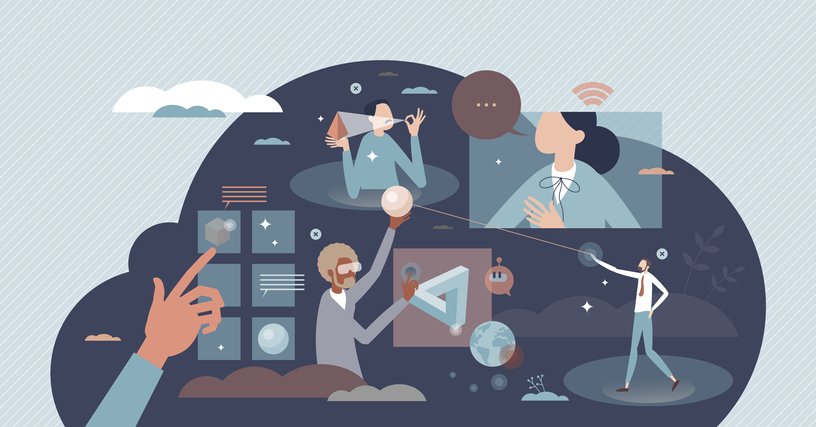Defining the Metaverse is somewhat like defining the Internet in the ’70s.
The uses of technology in distance education and online classes and virtual reality, and similar resources for didactic purposes have grown by leaps and bounds due to the health contingencies of the pandemic. The Metaverse is the next step in this sequence of advancements. We will discuss how the Tec Virtual Campus fits into this new dimension of reality on Wednesday, December 8 at 4:00 p.m. (Mexico City time) in our next webinar entitled, “Tec Virtual Campus, Metaverse for Academic Experiences and Student Life.” To make the most of the topics covered in this broadcast, we should first be clear about what comprises the Metaverse.
Trying to discuss the Metaverse today, define it, and agree on what it encompasses is very similar to the attempts to describe the Internet in the ‘70s and ‘80s. The latter is an integral part of our lives today, but once it was a project under construction. It was an idea that would potentially become something huge, entwined in the core fibers of human experience and worldview. Today, if we talk about the Metaverse, we talk more about potential than specific things.
That said, the only way we can define it today is… to not do it. What we have are attempts are approximations. The Metaverse does not refer to a particular technology with a specific use. Instead, it’s a wide range of technologies that could have new uses and purposes never previously conceived. Eric Ravenscraft, a product writer for the magazine Wired and content generator for The New York Times, suggests a mental exercise to help us better understand this idea: “Mentally replace the phrase the Metaverse in a sentence with cyberspace. Ninety percent of the time, the meaning won’t substantially change.” Ravenscraft explains that we refer to the Metaverse to name or understand the next step in what we know as cyberspace or the set of technologies on which we depend most to help forge our experiences and shape our reality.
The technologies that comprise the Metaverse include virtual reality and augmented reality, where worlds remain in force whether we are present in them or not. AR and VR are not the only access routes to these worlds. For example, we can now enter realities like “Fortnite” or “Second Life” via computers or game consoles; however, the new resources will be the next step of the experience.
The Metaverse conceives integrating aspects of interoperable digital economies, where users can create, buy, and sell goods that cross platforms. For example, physically buying a t-shirt and using a code to wear it on an avatar in a virtual reality world. Many things that could be considered components of a Metaverse already exist. We already use Facebook, for example. In a virtual world called “Second Life,” you can build and dress your avatar and go to concerts, dances, attend lectures, online classes, operate stores, use their currency for purchases, and have relationships. So, why didn’t we talk about the Metaverse before? The concept has been taking form as technologies have evolved, reaching a point where they can integrate much more and potentiate possibilities we may not even have considered. The Metaverse has not quite happened, but it will happen because the capacity and technologies for it exist.
An easy way to understand this process and capability is to look at the history of platforms such as Google and Facebook. The former began only as a search engine, the latter as a social network. Today, they make up the core fibers of seeking and receiving information and communicating and connecting with people. Similarly, the technologies we have today, their intersections, and, importantly, how we use them will determine how we will shape our future environments.
What does this mean for the future of education? How can these new technologies make teachers’ work easier or improve the student experience? Could they do more than we conceive? To guide us in this area, Ursula Saldívar Dávila, Clinical Psychologist and a professor in Education at Tecnologico de Monterrey, will accompany us in the next webinar. In addition to being a teacher and psychologist at the upper secondary level (high school), she has collaborated in Innovation and User Experience, helping the adaptation and accompaniment in the process of digital transformation. She has also participated in generating open innovation models that allow knowledge transfer. She is currently the leader of Educational Technology Projects in the Mostly Laboratory of Emerging Technologies.
Professor Saldivar will discuss the migration to online life from the education perspective and the Tec Virtual Campus, a 3D virtual world created by Tecnologico de Monterrey. We will detail the project, which offers students a memorable experience that transcends the barriers of a physical campus. More than six thousand students have had the opportunity to interact, take classes, and attend events in this space. If you want to know more, do not miss our next webinar this Wednesday, December 8, at 4:00 p.m. (Mexico City time). The webinar will be conducted in Spanish.
Translation by Daniel Wetta
This article from Observatory of the Institute for the Future of Education may be shared under the terms of the license CC BY-NC-SA 4.0 
)
)


)